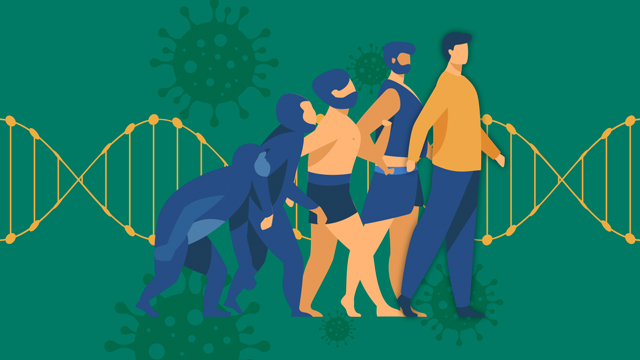

“What you see in this ring before you is the greatest example of evolution you will ever see,” declared WWE icon Triple H in front of roaring thousands. Biologists in attendance would’ve been livid at the proclamation, but they were probably distracted by the anatomical spectacle on stage. Also, Triple H wasn’t defending a dissertation, he was merely describing the new faction he, Ric Flair, Randy Orton, and Batista had just formed. They believed that they set a new standard for professional wrestling so they called themselves “Evolution,” borrowing a term from biology to denote their superiority over all others. For the fans who religiously followed the events leading up to this point, the announcement came as no surprise as it had been a long time coming.
In 2020, however, the world was caught surprised by an evolution, an even greater one than Triple H’s. It pinned down many to their defeats and demise. It knew no bounds, no rings, no rules. It had no large muscles to make it more obvious to the human eye, as this evolution downsized preferring invisibility. In comparison to Triple H and company’s weekly showing, this evolution has a meaner daily streak that still continues today. And there’s no signs of it stopping just yet.
I’m talking about the eventual evolution of SARS-CoV-2 (the virus that causes COVID-19) and the pandemic it caused.
From a political standpoint, the COVID-19 pandemic has been a total tragedy with so many unnecessary casualties thanks to government mishandlings. But from a biological view, it has been a total marvel. Marvelous not in any morbid sense, but because natural selection has again proven itself as a powerful force to be respected.
To doctors and health researchers worldwide, this is an urgent reminder to imbue medicine with a strict evolutionary paradigm. The influence of private health care has shaped the delivery of medicine to be as “curative” as possible because of its high profit returns. This focus on cure and therapy regimes has robbed medicine of the richness of Darwinian thought in understanding the complexities of health. And with COVID-19 wreaking havoc, we are in deep need of its guidance. Especially valuable is the Darwinian emphasis on biological unity and natural history. Both will inevitably prove useful to doctors and medical researchers as they will help understand past occurrences of diseases and predict future public health crises. And the best place for this reintegration is in medical schools.
To do just that, medical schools need radical revisions in both their educational structure and institutional infrastructures.
Darwinian diseases
After tracing the lineal descents of various species, Darwin correctly concluded in On the Origin of Species that “all living things have much in common.” This commonality is now obvious to the modern eye and is widely accepted even by the lay. A quick glimpse at the eyes of a pensive orangutan is enough to affirm our hominid kinship without even getting down to genetics. For doctors and medical researchers, Darwin’s conclusion has crucial implications to human health that is worthy of study.
The recent spate of infectious diseases surfacing from time to time in human societies have mostly come from animal sources. This is because our immune systems are still patently animal, and that our pathological responses to pathogens are not so much different fundamentally, but simply by degree. Zoonotic transmission among species, especially to us, points to the potency of Darwin’s implication that there must be something common in our bodies that enables the very same agents to cause similar pathological reactions. Cattle driven to madness by bovine spongiform encephalopathy (or Mad Cow Disease) has the potential to transmit a human variant of the disease called Creutzfeldt-Jakob disease (vCJD) to people with a liking for beef. The cattle killer and its human counterpart both attack the nervous system. Different species, same target. (READ: [ANALYSIS] Ecological irresponsibility and pandemics)
Our shared evolutionary history with other species demands that we include other biological fields in our medical programs in order to broaden our understanding of health. Many colleges and universities often structure their biology courses as “pre-med,” as a mere preparatory course for medicine. But since human beings are biological organisms that undergo the same evolutionary mechanisms as other organisms, biology should always be the principal core of medical education, not just a preface to it. This is why evolution is so important to medicine because, “nothing in biology makes sense except in the light of evolution,” as said by the late geneticist Theodosius Dobzhansky. What this suggests is that botany, zoology, systematics, etc. should still be integral modules in medical courses. Without these, our current healthcare systems will be often left unprepared to deal with new outbreaks, which is what happened with COVID-19.
The eruption of SARS-CoV-2 caught many by surprise, even doctors and scientists. It’s highly regrettable because researchers from Hong Kong already sounded the alarm back in 2007 for a bat-borne virus with a pandemic potential to emerge out of China. They wrote: “The presence of a large reservoir of SARS-CoV like viruses in horseshoe bats, together with the culture of eating exotic mammals in southern China, is a time bomb. The possibility of the reemergence of SARS and other novel viruses from animals or laboratories and therefore the need for preparedness should not be ignored.” From an evolutionary standpoint, their prediction made much sense because the eventual arrival of SARS-CoV-2 was long overdue given that the conditions for the evolution and transmission of the virus were already in place. A Darwinian approach to medicine would have equipped medical researchers and practitioners with the right intuition to anticipate such transfers and enabled them to devise the necessary preventive interventions. Of course, state action and inaction are the most decisive aspects. But having an extra treasury of knowledge surely helps. (READ: [OPINION] The animal industry can be the next pandemic ground zero)
Infrastructures for evolutionary thought
As biological unity is emphasized in Darwinian medicine, medical schools shouldn’t just be proximal to hospitals, but they should also be within range of other research facilities (and communities in dire need of medical aid). This will better promote physical collaboration with other specialists, enabling doctors to have new insights on infectious diseases. For example, having epidemiologists closely work with botanists and entomologists will likely result in a better understanding of the reciprocal relationships in forests that keep populations of disease vectors in check. Conversely, collaborative research on the prevalent diseases experienced by populations near deforested areas will also be of vital importance not just in saving more lives, but also in conservation efforts. Medical students and researchers should be constantly exposed to various fields that investigate the larger networks that affect human health, so the location of medical institutions should also be reconsidered. Hospitals are mainly to restore health, maintaining good health is an affair outside of it. (READ: [OPINION] Medicine has its own cancer that needs curing)
Of course, these suggestions will hardly take place in the current economic system. Capitalism’s interest is only making profits; our health is merely a means to it. Radical overhauls in medical praxis, if we are to take examples from history, will only follow radical changes in politics. So the drive must not only come from an internal reflex, but from society in general. If such a transition does happen, and medicine finally buries the cadaver of capitalism to give rise to the spectre of Darwin, then perhaps we can rightly borrow Triple H’s words and proclaim medicine as “the greatest example of intellectual evolution you will ever see.” – Rappler.com
Pippo Carmona is a biologist and historian of medicine. He writes history and science ramblings in his blog, SCALPEN.